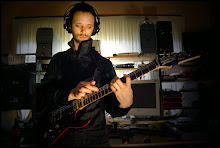Week ending 06/04/2006
Post for week ending 06/04/2006Audio Arts:
Focus: Headphone monitoring possibilities and limitations for all recording spaces in EMU.
For sending a headphone mix to the dead room from studio 1 let me get this straight;
- Sound source is in the dead room
- Microphone is in the dead room receiving the sound source
- Microphone is plugged into studio 1 jack 1 on dead room wall bay
So, to receive this signal in studio 1 we must remove the jack from the top left of the studio 1 wall bay and place it in the far left plug for receiving from the dead room.
Then to get a headphone signal;
- On the patch bay, route from output Aux L&R to headphone in L&R.
- Then click on the ‘monitor auxiliary’ button on C24
- Adjust auxiliary volume as required
- Check level is coming through on the headphone amp
Headphone signal must then be routed to Studio 2.
- On the EMU space wall bay route the headphone out 1 plug to the headphone in 3 or 4 of studio 2
- In studio 2 route the incoming signal from headphone outs 3 or 4 on the wall bay to headphone 5 which goes to headphone out 5 on the dead room wall bay
- Plug the headphones into the dead room wall bay and its time……………….. to ROCK!
Ps; for non recording line monitoring of the recording space plug a Mic into input 17 on the EMU space wall bay and crank up the ‘monitor listen’ fader knob.
References:
Christian Haines. "Audio Arts - Studio 1." Practical Class presented at Studio 1, EMU space, 5th floor, Schulz Building, University of Adelaide, 4th April 2006.
Forum part 1, listening:
1. Edgard Varese, born in Paris 1883 died New York, 1965;

Equatorial:
Well, the father of electronic music eh? Perhaps the father of incorporating early electronic instruments into an organised sound structure would be a more fitting title in relation to this piece.
He seems to be going for a very dramatic effect in this composition. The instrumentation still sounds very orchestral despite the inclusion of the Ondes Martenot machines. It reminds me of John Cage to a certain extent but sounds less disjointed than some of Cages’ pieces.
The harmony at the end was a nice touch after the bombardment of aggressive horn playing.
2. Milton Babbit;
Ensembles for synthesiser:
Serial music. Some interesting melodies and rhythmic patterns turned up here and there but overall it reminded me of my computers inbuilt speaker when it’s connecting to the internet.
The thing that frustrates me the most about serial music (especially integral serialism) is that when you hear a passage that you actually like you know there is little chance of hearing it again.
3. Barry Truax;
Wings of Nike 1 album. 1987.
This I like, it conjures images of cavernous surroundings. Something like the inside of an extinct volcano. I feel this kind of sound design has numerous applications, especially incidentally in film or the video game industry.
References:
¬“Edgard Varese, the Father of Electronic Music”. 1996. Accessed: 06/04/2006
http://personal-pages.lvc.edu/~snyder/em/varese.html
Greg Sandow. “The fine Madness of Milton Babbit”. 2004. Accessed 06/04/2006
http://www.gregsandow.com/babbitt.htm
David Harris. "Music Technology Workshop – Electronic Music." Lecture presented at the Electronic Music Unit, EMU space, University of Adelaide, 06th April 2006.
Part 2. The Squawk Box;
I don’t like to think about the inevitability of University merging with business in the future. I think this will be detrimental to the evolution of an academic society. No longer will avenues of scholarly study be undertaken purely for academic purposes. Indeed if there is no money making vocational outcome at the end of one’s degree displayed in flashing neon lights then it will most likely be considered an impractical course of study and eventually dropped from a Universities list. This is not a good sign for the Arts in my opinion, and is certainly a step away from a creative and free thinking nation.
On another subject covered I think it would serve students and the university in the future to offer a choice of Core subjects related to a degree in Music Technology. There are a considerable number who have no desire for traditional theory knowledge and realistically will probably never use it if their focus is more on sound design and programming software. I have a keen interest in music theory and history myself but I do think a good point has been raised nevertheless.
References:
Stephen Whittington. "Industry Discussion – What is Music Technology." Lecture presented at the Electronic Music Unit, EMU space, University of Adelaide, 30 March 2006.
Creative Computing;
Sound hack:
I remember well the torture of using sound hack in the nineties with slow old Mac’s. As a result I don’t think I’ve actually used the program since. Using the Phase Vocoder function on a G5 however is a whole new ball game. It seems that this program, written some 10 years ago is only realising its potential now. I managed to create an eight minute soundscape from a 10 second sound file using the function window in the phase vocoder. The result was actually quite pleasing. More on this next time………………
Audio Example: (coming soon)
try this
References:
Christian Haines. "Creative Computing - Soundhack." Lecture presented at the Audio Lab, 4th floor, Schulz Building, University of Adelaide, 06th April 2006.


0 Comments:
Post a Comment
<< Home